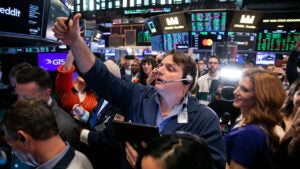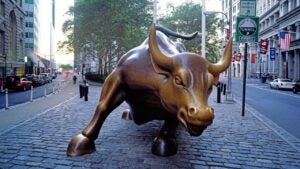Survey: Expect the S&P 500 to push nearly 9% higher over the next year, say market experts

For a third straight quarter, experts believe the stock market will continue to rise over the coming year, according to a new survey from Bankrate. The Second-Quarter Market Mavens survey revealed that analysts are projecting a 8.7 percent gain in the Standard & Poor’s 500 Index (S&P 500) over the coming 12 months. Notably, not a single analyst expected the index to fall.
The numbers were in line with the estimates of the prior two quarters as well, with forecasted gains of 8.9 and 8.5 percent. The market has climbed around 14 percent since the start of the year.
But even with the market setting new all-time highs, analysts remain upbeat about its near-term prospects, despite the specter of a rate increase from the Federal Reserve. They also prefer value stocks and global stocks, according to the survey.
“One of the sources of uncertainty over the next year is Federal Reserve policy,” says Mark Hamrick, Bankrate’s senior economic analyst. “Or put another way, will the central bank boost interest rates sooner rather than later? That is a risk to be sure. But rising rates would be a logical response to a normalizing, post-crisis economy. So that alone is not a reason to dissuade investors from seizing upon opportunity in the coming year or so.”
Bankrate’s survey asked 11 experts the direction of the stock market over the next 12 months, whether U.S stocks were a better choice than global stocks, whether growth stocks would outperform value stocks, where the 10-year Treasury yield will go, and more. The survey also asked about the risk of inflation and solicited expert advice for individual investors.
Key takeaways:
- Market Mavens expect an 8.7 percent gain in the S&P 500 over the coming year.
- Only 18 percent of respondents expect the market will deliver higher-than-average returns over the next five years.
- A majority of experts prefer global stocks over U.S. stocks, and more than half prefer value stocks over flashier growth stocks.
- Analysts expect a modest climb in the 10-year Treasury yield to 1.92 percent.
- Experts are nearly divided on whether the market is pricing inflation correctly or underpricing it, though none think it’s being overpriced.
- Finally, these analysts passed along their perspective for individual investors and how they should invest in this environment.
Experts: S&P 500 to rise nearly 9 percent over the next year
Despite the market’s strong upward momentum from the sharp declines of 2020, the Market Mavens remain optimistic about returns over the next year. They expect a gain of 8.7 percent, with the market projected to rise from its close of 4,223.70 on June 16 to 4592.60 by June 2022. Notably every single analyst who offered a projection expected the S&P to rise over the period.
The second-quarter results are in line with the last two surveys, when analysts predicted forward gains of 8.5 percent in the first quarter and 8.9 percent in the fourth quarter of 2020. Those predictions are not far from the S&P 500’s long-term average return of about 10 percent.
These optimistic expectations may be a cause for reflection for those who may be shying away from stocks due to fears about inflation and its potential effects on the market.
“One of our consistent findings from individuals is that a top financial regret is the failure to save for retirement,” says Hamrick. “One must be invested for the long term to produce the superior returns that are necessary to outpace inflation. And now that inflation has reared its would-be head, at least for now, it becomes even more timely.”
Just 18 percent expect the market to outperform long-term averages over next five years
Respondents to Bankrate’s survey were not wildly bullish about the market’s performance over the next five years:
- About 45 percent said the market would perform at the same level as its historical average.
- Around 18 percent expected returns would likely be better than the long-run average.
- More than 36 percent said returns would be below the historical average.
Those figures were largely in line with the results of the first-quarter survey, and respondents pointed to several reasons for their answers.
“We’re early in a cycle and returns tend to be higher in the periods coming out of recessions,” says Sameer Samana, senior global market strategist, Wells Fargo Investment Institute in St. Louis. Samana expects above-trend returns over the next half-decade.
Meanwhile, Patrick J. O’Hare, Briefing.com chief market analyst, thinks returns will be lower than normal.
“It’s very difficult to forecast so far ahead, but taking into account today that we are starting from a point of high valuation, an extraordinarily high deficit, and in an environment where it is thought tax rates will need to go up to help lower the deficit, the assumption today is that future returns will likely be lower than normal,” he says.
But Robert Woessner, an investment analyst at Berman Capital Advisors, was among the plurality of respondents who expected returns to be about the same as they’ve been historically: “While we are in a strong growth period now, relative to 2020, growth rates will temper going forward and revert to long-term trend as the economy normalizes.”
Mavens prefer global and value stocks
The survey asked experts whether they preferred global or U.S. stocks and whether they liked value or growth equities better over the next year. Overall, respondents preferred global and value stocks, and here’s how the numbers break down:
- More than 64 percent preferred global equities over the next 12 months.
- About 36 percent tapped U.S. stocks to outperform global stocks.
- No analysts expected the returns to be about equal.
For context, in the first quarter survey, analysts were more divided, with 40 percent favoring either global or U.S. stocks and the remaining 20 percent expecting returns to be nearly equal.
Some analysts pointed to global equities because many foreign countries have yet to really begin their recovery phase.
“The U.S. economy is ahead of other economies in the reopening process,” says Michael Farr, president and CEO, Farr, Miller & Washington. “While we expect good returns domestically, others have yet to enjoy the early, steep part of the recovery.”
“International economies have just begun to recover from the pandemic,” says Chuck Self, chief investment officer, iSectors, an ETF strategist based in Appleton, Wisconsin. “They are behind the U.S. This should lead to international stocks outperforming domestic stocks.”
But U.S. stocks are a good way to play the global rebound, says Kim Forrest, CIO and founder, Bokeh Capital Partners in Pittsburgh.
“The U.S. is the first region to be coming out of the COVID lockdowns,” says Forrest. “Our companies have exposure to all parts of the world and will continue to benefit from global reflation.”
When it comes to value stocks and their growth cousins, analysts continue to prefer value stocks:
- About 55 percent of analysts cited value stocks as their top pick.
- More than 27 percent favored growth stocks.
- About 18 percent of respondents expected returns to be about the same.
The numbers looked similar to the results of recent quarterly surveys, with analysts strongly favoring value stocks of late, as shown in the graphic below.
“As interest rates rise, there tends to be a negative correlation for the outperformance of growth to value stocks,” says Kenneth Chavis IV, CFP, a senior wealth manager at LourdMurray, pointing to value stocks as his pick.
Meanwhile, Farr thinks value stocks are poised for a more extensive rebound, and says, “I believe a long-anticipated rotation to value is still in its early stage and could last for years.”
But Forrest thinks growth is the place to be for a few reasons: “Growth wins in an inflationary environment, if you believe inflation is not transitory. It also wins as the economy expands. We’ve had a bit of a catch up from lagging stocks but growth is what Wall Street rewards.”
O’Hare expects modest returns but sees investors tripping over how the Federal Reserve will manage the economy and the uncertainty surrounding it.
“Accordingly, we expect more of the same ongoing rotation between these particular factors that keeps them on a comparable performance path,” he says.
Experts see the 10-year Treasury yield rising
Over the coming year the experts surveyed by Bankrate see only a modest move in the benchmark 10-year Treasury rate. On average, analysts are expecting the rate to rise to 1.92 percent, up from 1.57 percent at the end of the survey period. Estimates ranged from 1.25 percent to 2.5 percent.
For context, the Market Mavens expected the yield on the 10-year Treasury to be 1.95 percent at the end of March 2022. That was significantly higher than the fourth-quarter survey’s estimate of 1.2 percent for December 2021, so analysts ratcheted up their expectations quickly.
“The Fed is more concerned about broad-based improvements in employment than fears of unanchored inflation,” says Dec Mullarkey, managing director, SLC Management in Toronto. “Therefore, paying attention to labor market health is key to anticipating Fed policy.”
Experts are nearly divided on inflation outlook and the market’s response
The Bankrate survey also asked these economic experts about the risks of inflation over the next 12 to 18 months and whether the market was pricing it right, underpricing it or overpricing it:
- About 55 percent of respondents said the market is pricing inflation right.
- About 45 percent said risk is being underpriced.
- No one said the risk of inflation is being overpriced.
The survey shows a sharp shift on inflation from the first quarter when 30 percent of experts said that inflation was being overpriced by the market. Since that time, rates on the 10-year Treasury have come down and the market has continued to rise, suggesting they were right.
Tom Lydon, CEO at ETF Trends, thinks markets are underpricing inflation, and notes that the “Fed doesn’t believe it, but Americans do.”
“Money supply has exploded, surplus savings have exploded, and asset prices have inflated rapidly,” says O’Hare, pointing to underpricing. “There is a lot of spending potential wrapped up in that combination against a backdrop where supply factors may not be able to keep pace given a simultaneous unleashing of pent-up demand globally.”
But others think the Fed has it right and that inflation will be transitory.
“We agree with the Fed that, while prices are indeed rising, the spike will be short-lived,” says Sam Stovall, chief investment strategist, CFRA in New York City.
“The U.S. has had structural deflation since the 1980s and it is difficult to get off that trend,” says Woessner. “The pandemic caused supply and demand imbalances but most effects should be temporary. Globalization, demographics and technology are still major factors that compress prices.”
Expert ‘need-to-know’ advice for individual investors
Bankrate also threw out a wildcard question to its market mavens, asking for an insight and “something timely that a typical individual investor should know.” Here are a few responses, and many of our respondents generally tell investors to focus on the long term.
“Remember that even the so-called financial experts who attempt to time the market are wrong most of the time,” says Chavis. “As is always the case, now is the time to maintain discipline in your investment strategy, which should be comprised of a diversified portfolio of assets allocated in line with your unique circumstances, time horizon and risk profile.”
“My best advice: Stick to your long-term asset allocation,” says Farr. “Don’t change your strategy based on short-term noise and emotion. Time and not timing [the market] earns good returns over the long run.”
“It always feels like a market’s best days are behind it,” says Forrest. “Don’t let it discourage you. Ownership (risk) is generally rewarded.”
But even if you’re looking to trade a little bit, one of our mavens offers a clue what to watch for.
“Pay attention to the Dow Jones Transportation Average,” says Chuck Carlson, CFA, CEO, Horizon Investment Services. “The Transports are very sensitive to economic conditions. Since major market declines are spurred by significant deterioration in the economy, the Transports are often the ‘canary in the coal mine,’ providing early warning signals.”
Methodology
Bankrate’s second-quarter 2021 survey of stock market professionals was conducted from June 9-16 via an online poll. Survey requests were emailed to potential respondents nationwide, and responses were submitted voluntarily via a website. Responding were: Chuck Carlson, CFA, CEO, Horizon Investment Services; Chuck Self, chief investment officer, iSectors; Sam Stovall, chief investment strategist, CFRA Research; Patrick J. O’Hare, Briefing.com chief market analyst; Kim Forrest, chief investment officer/founder, Bokeh Capital Partners; Tom Lydon, CEO, ETF Trends; Sameer Samana, senior global market strategist, Wells Fargo Investment Institute; Dec Mullarkey, managing director, SLC Management; Robert Woessner, investment analyst, Berman Capital Advisors; Michael Farr, president and CEO, Farr, Miller & Washington; Kenneth Chavis IV, CFP, senior wealth manager, LourdMurray.






